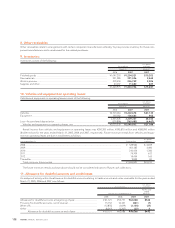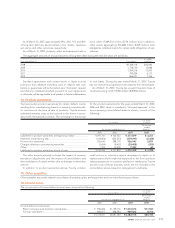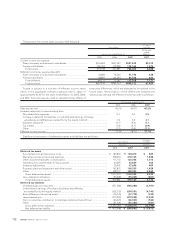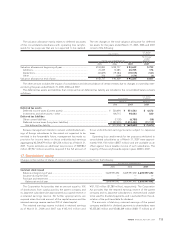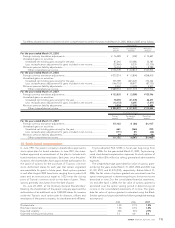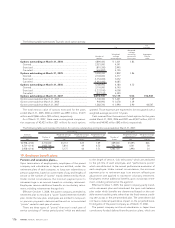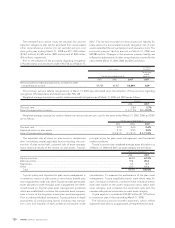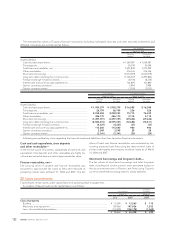Toyota 2007 Annual Report Download - page 119
Download and view the complete annual report
Please find page 119 of the 2007 Toyota annual report below. You can navigate through the pages in the report by either clicking on the pages listed below, or by using the keyword search tool below to find specific information within the annual report.
ANNUAL REPORT 2007 117
pursuant to the Corporate Defined Benefit Pension Plan Law
(CDBPPL). The contributions to the plans are funded with sever-
al financial institutions in accordance with the applicable laws
and regulations. These pension plan assets consist principally of
investments in government obligations, equity and fixed
income securities, and insurance contracts.
Most foreign subsidiaries have pension plans or severance
indemnity plans covering substantially all of their employees
under which the cost of benefits are currently invested or
accrued. The benefits for these plans are based primarily on
lengths of service and current rates of pay.
Toyota uses a March 31 measurement date for the majority of
its benefit plans.
Transfer to the government of the Substitutional
Portion of the Employee Pension Fund Liabilities—
The parent company and most subsidiaries in Japan had main-
tained employees’ pension funds (EPFs) pursuant to the
Japanese Welfare Pension Insurance Law (“JWPIL”). The EPF
consisted of two tiers, a Substitutional Portion, in which the EPF,
in lieu of the government’s social insurance program, collected
contributions, funded them and paid benefits to the employees
with respect to the pay-related portion of the old-age pension
benefits prescribed by JWPIL, and a Corporate Portion which
was established at the discretion of each employer.
In June 2001, the CDBPPL was enacted and allowed any EPF
to terminate its operation relating to the Substitutional Portion
that in the past an EPF had operated and managed in lieu of
the government, subject to approval from the Japanese
Minister of Health, Labour and Welfare. In September 2003,
Toyota Motor Pension Fund, the parent company’s EPF under
JWPIL, obtained the approval from the Minister for the exemption
from benefit payments related to employee services of the
Substitutional Portion. In January 2004, Toyota Motor Pension
Fund completed the transfer of the plan assets attributable to
the Substitutional Portion to the government. In addition, dur-
ing the years ended March 31, 2004 and 2005, subsidiaries in
Japan that had EPFs under JWPIL also completed the transfer
of the plan assets attributable to the Substitutional Portion in
compliance with the same procedures followed by the parent
company.
In accordance with the consensus on EITF Issue No. 03-2,
Accounting for the Transfer to the Japanese Government of the
Substitutional Portion of Employee Pension Fund Liabilities
(“EITF 03-2”), Toyota accounted the entire separation process,
upon completion of transfer of the plan assets attributable to
the Substitutional Portion to the government, as a single settle-
ment transaction. During the year ended March 31, 2005,
Toyota recognized a settlement loss of ¥96,066 million as part
of net periodic pension cost which is the proportionate amount
of the net unrecognized loss immediately prior to the separa-
tion related to the entire EPFs under JWPIL, and which is deter-
mined based on the proportion of the projected benefit
obligation settled to the total projected benefit obligation
immediately prior to the separation. Toyota also recognized as
a reduction of net periodic pension cost totaling ¥21,722 million
for the year ended March 31, 2005, which resulted in a gain
attributed to the derecognition of previously accrued salary
progression. In addition, Toyota recognized a gain of ¥121,553
million for the year ended March 31, 2005, which represented
the difference between the obligation settled and the assets
transferred to the government. These gains and loss are reflect-
ed in the consolidated statement of income for the year ended
March 31, 2005 as follows:
Yen in millions
For the year ended March 31, 2005
Costs of Selling, general
products sold and administrative Total
Settlement loss....................................................................................................................... ¥(85,379) ¥ (10,687) ¥ (96,066)
Gain on derecognition of previously accrued salary progression..................................... 19,494 2,228 21,722
Gain on difference between the obligation settled and the assets transferred .............. — 121,553 121,553
Total.................................................................................................................................... ¥(65,885) ¥113,094 ¥ 47,209
All these gains and loss are non-cash gains and loss, and
reported on a net basis in “Pension and severance costs, less
payments” in the consolidated statement of cash flows for the
year ended March 31, 2005.
During the years ended March 31, 2006 and 2007, no signifi-
cant gains or losses relating to the transfer to the government
of the Substitutional Portion of the EPF liabilities were recognized.
The impact of adopting FAS 158—
Toyota adopted the provisions regarding recognition of funded
status and disclosure under FAS 158 as of March 31, 2007.
Toyota recognized the overfunded or underfunded status of its
defined benefit postretirement plans as prepaid pension and
severance costs or accrued pension and severance costs on its
consolidated balance sheet, with corresponding adjustments to
accumulated other comprehensive income, net of tax. The
impacts of adopting the provisions of FAS 158 on Toyota’s con-
solidated balance sheet as of March 31, 2007 are as follows. The
adoption of the provisions had no impact on Toyota’s consoli-
dated statement of income for the year ended March 31, 2007.



